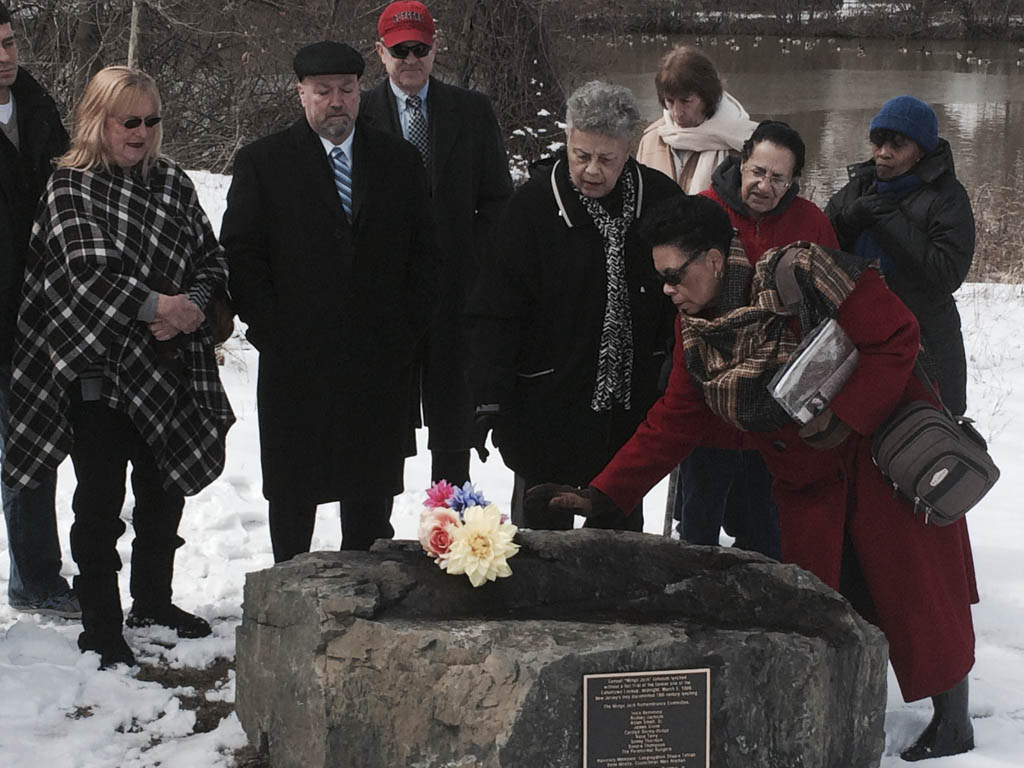By MICHAEL NUNES
Staff Writer
EATONTOWN — The date was March 5, 1886. Samuel Johnson, known as Mingo Jack, sat in a two-cell lockup awaiting trial after being accused of raping a white woman.
That trial would never come.
At around midnight on that day, a mob gathered outside the lockup ready to name themselves judge, jury and executioner.
Their sentence was death.
So goes the story of Monmouth County’s first documented lynching, and the only one documented in the state during the 19th century.
“You usually think of lynching in the South, not up here in the North,” said Sondra Thompson, a member of Eatontown’s Historical Committee.
The event occurred in current day Wampum Memorial Park. In 2012, the location was marked with a boulder that was paid for through donations.
For the 130-year anniversary of Johnson’s lynching, a crowd of lifelong residents, council members and local history buffs gathered for a somber ceremony at Wampum Memorial Park on Saturday, March 5.
“This is not a celebration by any means. … It’s more of a remembrance of a time long ago that should never have happened, and unfortunately it happened in my town,” said Mayor Dennis Connelly.
The group, which included members of the Mingo Jack Remembrance Committee, held a prayer at the boulder in honor of Johnson and laid flowers at the site.
Born in Colts Neck in 1820, Johnson was abandoned by his parents and raised by a white family, the Lairds. The Lairds used Johnson as a slave, and because of his size — he was short and stocky — as a jockey.
Johnson rode a horse named Chief Mingo to victory during a race, earning him the nickname Mingo Jack.
When New Jersey abolished slavery in the 1840s, Johnson left his former masters and began working odd jobs around Middletown and Eatontown.
Johnson lived in Eatontown, south of present-day Route 35 on Poplar Road before the incident took place.
Johnson, who was in his late 60s, lived in a small wooden cabin and cared for his then-bedridden wife. Most of his children were grown and had moved on.
Angeline Herbert, the woman who would accuse Johnson of raping her, lived near him.
Herbert, who was in her mid-20s and suffered from tuberculosis, only saw Johnson while he was working on his property. On the day of the alleged rape, Herbert went for a walk to return a tin baking dish to another neighbor.
While en route, Herbert was accosted by a man, beaten and raped. Herbert claimed it was Johnson who attacked her, and he was promptly arrested and brought to the local lockup.
Word of the attack spread quickly, and a crowd began to gather outside the lockup.
Seeking revenge for the attack, the mob began chiseling holes in the side of the building. Members of the group then stuck rifles into the holes in an attempt to kill Johnson.
When their guns couldn’t do the job, the crowd broke down the door to the tiny jail cell, dragged Johnson out, beat him to death and lynched him.
According to Councilman Anthony Talerico Jr., the story of Mingo Jack is not well known in the borough. It wasn’t until a few years ago that he heard about what happened, Talerico said.
“I think that, unfortunately, events that strike bad memories are pushed aside,” he said, adding that he was informed years ago by Thompson.
“The thing to focus on here was that no trial took place. Even if this man were guilty, he was entitled to a trial and then should been punished for his guilt, but he was never given a trial, and that’s the problem.
Despite the event being one of the darkest moments in the borough’s history, those who attended Saturday’s ceremony say it should still be remembered.
“This was clearly an event that people shouldn’t be proud of but, as a history lover, I feel that history needs to be understood. Both the good and the bad,” Talerico said.
“History is not just remembering the good, it’s understanding the bad and learning from it.”

